人教版(2019)必修 第二册Unit 1 Cultural Heritage Reading and Thinking 课件(33张)
文档属性
| 名称 | 人教版(2019)必修 第二册Unit 1 Cultural Heritage Reading and Thinking 课件(33张) | 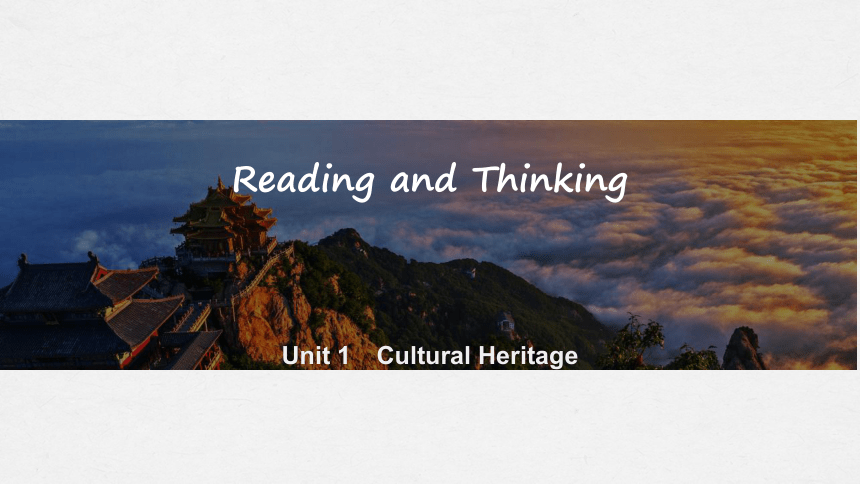 | |
| 格式 | pptx | ||
| 文件大小 | 63.2MB | ||
| 资源类型 | 教案 | ||
| 版本资源 | 人教版(2019) | ||
| 科目 | 英语 | ||
| 更新时间 | 2024-04-04 22:58:19 | ||
图片预览

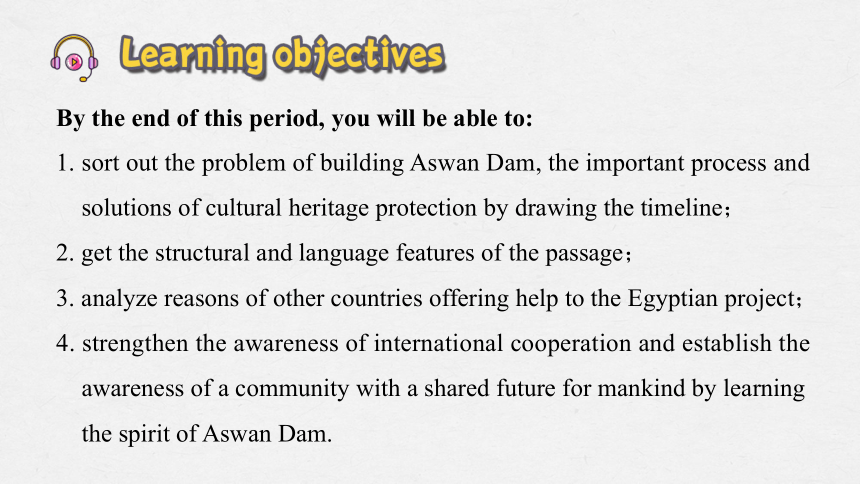

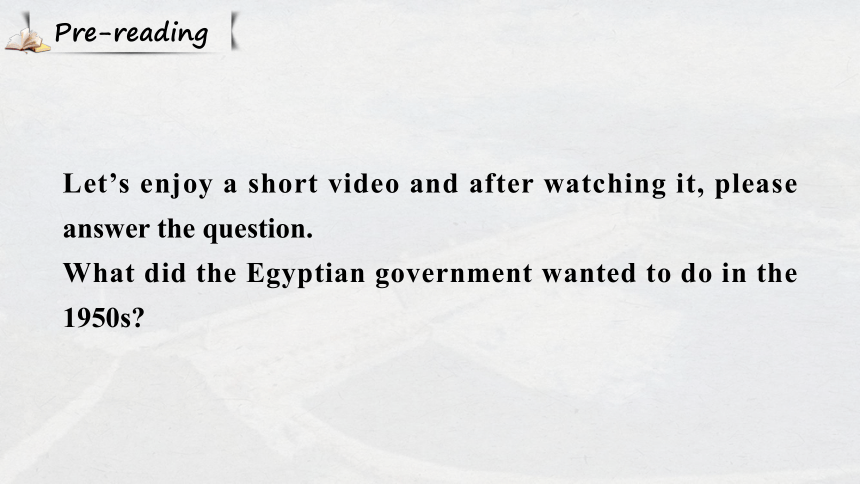


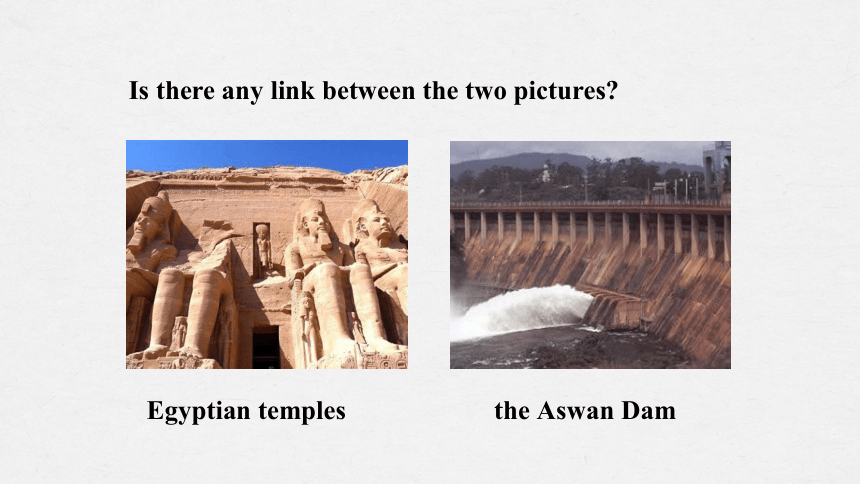
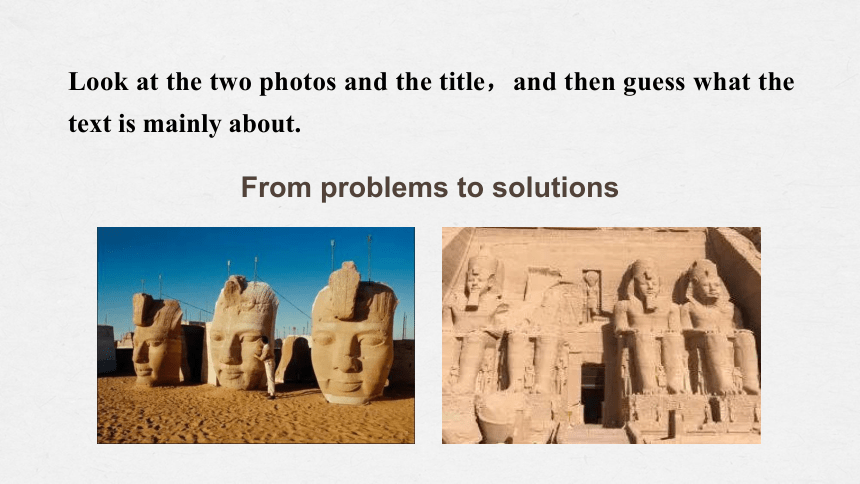

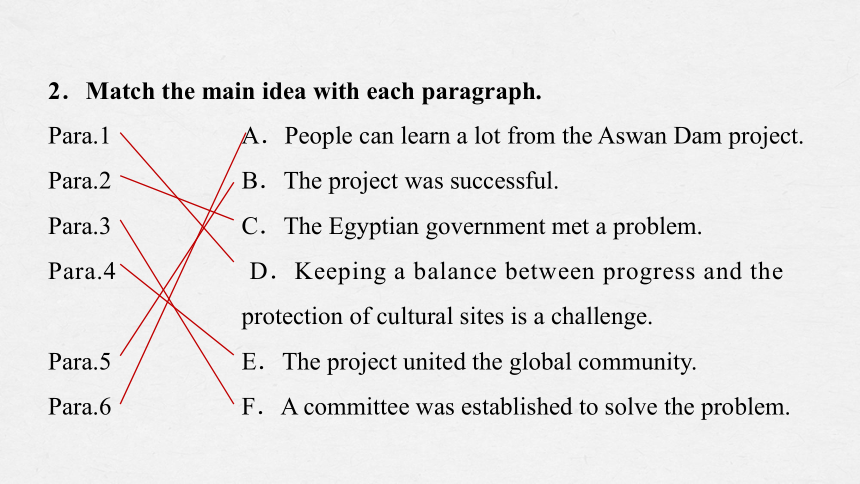
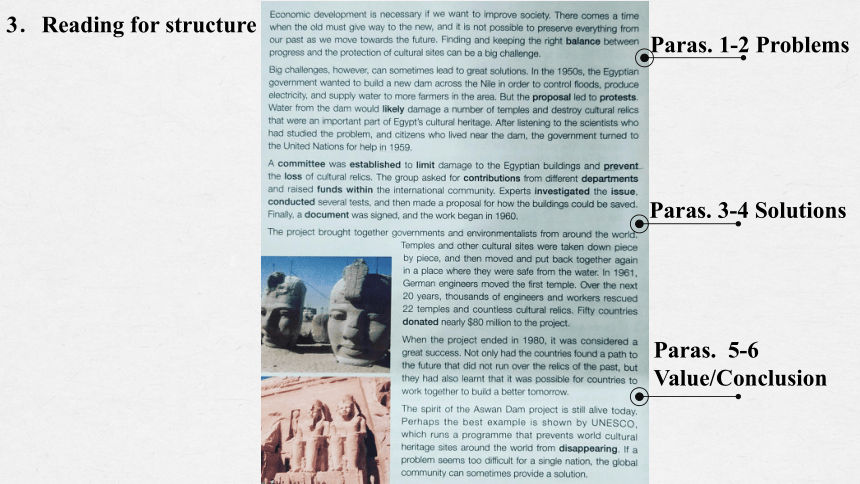
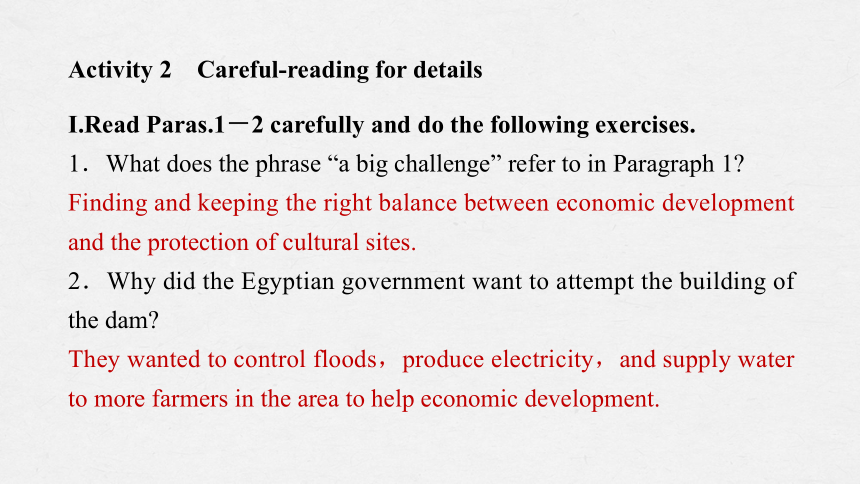
文档简介
(共33张PPT)
Reading and Thinking
Unit 1 Cultural Heritage
By the end of this period, you will be able to:
1. sort out the problem of building Aswan Dam, the important process and solutions of cultural heritage protection by drawing the timeline;
2. get the structural and language features of the passage;
3. analyze reasons of other countries offering help to the Egyptian project;
4. strengthen the awareness of international cooperation and establish the awareness of a community with a shared future for mankind by learning the spirit of Aswan Dam.
Heritage is our legacy(遗产) from the past, what we live with today, and what we pass on to future generations.
—World Heritage Centre
Pre-reading
Let’s enjoy a short video and after watching it, please answer the question.
What did the Egyptian government wanted to do in the 1950s
What did the Egyptian government wanted to do in the 1950s
In the 1950s, the Egyptian government wanted to build a new dam across the Nile
What was a big challenge before the government built the new dam
Is there any link between the two pictures
Egyptian temples
the Aswan Dam
Look at the two photos and the title,and then guess what the text is mainly about.
From problems to solutions
Activity 1 Fast-reading for main ideas
1. What’s the main idea of the text
A.A committee was needed.
B.The proposal leads to protests.
C.A big challenge can sometimes lead to great solutions.
D.A project of a new dam was successful.
While-reading
√
2.Match the main idea with each paragraph.
Para.1 A.People can learn a lot from the Aswan Dam project.
Para.2 B.The project was successful.
Para.3 C.The Egyptian government met a problem.
Para.4 D.Keeping a balance between progress and the protection of cultural sites is a challenge.
Para.5 E.The project united the global community.
Para.6 F.A committee was established to solve the problem.
Paras. 1-2 Problems
Paras. 3-4 Solutions
Paras. 5-6
Value/Conclusion
3.Reading for structure
Ⅰ.Read Paras.1-2 carefully and do the following exercises.
1.What does the phrase “a big challenge” refer to in Paragraph 1
Finding and keeping the right balance between economic development and the protection of cultural sites.
2.Why did the Egyptian government want to attempt the building of the dam
They wanted to control floods,produce electricity,and supply water to more farmers in the area to help economic development.
Activity 2 Careful-reading for details
3.What does the word “protest” in paragraph 2 mean
A.Support. B.Agreement.
C.Objection. D.Complaint.
4.Why did people object to the proposal
Because water from the dam would likely damage a number of temples and destroy cultural relics that were an important part of Egypt’s cultural heritage.
√
Ⅱ.Read Paras.3-4 carefully and do the following exercises.
1.What preparations did the committee make before the work began
①asked for _____________;
②raised _____;
③____________ the issue;
④_________ several tests;
⑤made a ________;
⑥signed a ________.
contributions
funds
investigated
conducted
proposal
document
2.How were the temples and other cultural sites saved
who
what rescue/save (verbs) were ____________ in pieces
________ to a safe place
__________ together again
cost ___________ dollars
result ___ temples and ________ relics were rescued
Egyptian government, UNESCO, fifty countries, environmentalists, engineers, workers
taken down
moved
put back
80 million
22
countless
win-win
合作 共赢
3.What can you infer from “Fifty countries donated nearly $80 million to the project”?
The project cost ______________. Many countries took part and offered _________________ in the rescue and it is their _________ that has saved the temples.
a lot of money
financial support
team work
Ⅲ.Read Paras.2-5 carefully and do the following exercises.
1. Find all numbers in the text.
detailed,
objective and convincing
2. Why does the author use exact numbers instead of expressions like “a lot of” ?
3. List the process of the project. Make a time line.
The government turned to the UN for help.
______________.
__________________________.
________________________________________.
_________________________.
The work began
The first temple was moved
The temples and cultural relics were being rescued
The project was completed
1959
1960
1961
Over the next 20 years
1980
Ⅳ.Read Paras.5-6 carefully and do the following exercises.
1.Why does the writer say the Aswan Dam project is a great success
Because not only had the countries found a path to the future that did not run over the relics of the past,but they had also learnt that it was possible for countries to work together to build a better tomorrow.
2.What is the spirit of the Aswan Dam project
A.The global community can sometimes provide a solution to a difficult problem for a single country.
B.The UNESCO is necessary in solving difficult problems.
C.Keeping the right balance between progress and the protection of cultural sites is a big challenge.
D.Economic development is necessary if we want to improve society.
√
Ⅴ.Read the passage again and discuss the following questions.
1.What can we know from the passage
A.Doing is better than saying. B.Many hands make light work.
C.There is no royal road to success. D.Experience is the mother of wisdom.
2.Where can we find such an article
A.In a guidebook. B.In an encyclopedia.
C.In a history novel. D.In a theme park advertisement.
√
√
Let’s enjoy this video and know more about it.
Post-reading
Activity 1 Discussion
1.A lot of money was spent to protect the temples.Do you think it was worthwhile Why or why not?(Critical thinking)
I think it was worthwhile to spend money on protecting the temples because their value is priceless in terms of cultural heritage.
2.“If a problem seems too difficult for a single nation,the global community can sometimes provide a solution.” What can you learn from the sentence?(Creative thinking)
From the sentence we can learn that in our daily life,we should not hide ourselves from others but seek help from our friends or families when we meet a difficult situation.
Why should we protect the cultural heritage
Cultural Heritage is the link of the past, the present and the future and is the historical and cultural treasure of a country and the world and we should protect it for the future generations.
Activity 2 Summary
Read the passage again and fill in the blanks.
In the 1950s,the Egyptian government wanted 1.________(build) a new dam across the Nile,2._____ led to protests.3._____(face) with the big challenge,the government had to turn to the United Nations for help.
A committee 4._______________(establish) to prevent the loss of cultural relics.They asked for contributions from different 5.___________(department) and raised funds within the international community.After investigating the issue and 6.__________(conduct) several tests,they made a proposal that temples and other cultural sites 7._________________(take) down piece by piece,and then moved and put back together in a place where they were safe from the water.
to build
which
Faced
was established
departments
conducting
(should) be taken
Over the next 20 years,thousands of engineers and workers rescued 22 temples and 8._________(count) cultural relics and fifty countries donated nearly $80 million to the project.The project was 9._ great success,and proved that big challenges can sometimes lead to great solutions.The countries learnt that 10.__ was possible for them to work together to build a better tomorrow.
countless
a
it
1.There comes a time when the old must give way to the new,and it is not possible to preserve everything from our past as we move towards the future.
[句式分析] 此句是________句。前一分句中表示方位的副词there位于句首,句子用________结构,when引导____从句,先行词为a time;短语give way to的意思是“___________________”。后一分句中it是________,不定式短语to preserve everything from our past作__________,as引导________从句。
[自主翻译]
并列复合
完全倒装
定语
屈服,向……让步
形式主语
真正的主语
时间状语
新旧更替的时代已经到来,在走向未来的过程中,我们不可能将过去的一切都保存下来。
2.After listening to the scientists who had studied the problem,and citizens who lived near the dam,the government turned to the United Nations for help in 1959.
[句式分析] 此句是____句。after在此处是__词;两个who引导的都是____从句,在从句中作____,两个从句分别修饰scientists和citizens。
[自主翻译]
复合
介
定语
主语
在听取了研究该问题的科学家以及大坝附近居民的意见后,政府于1959年向联合国寻求帮助。
3.Not only had the countries found a path to the future that did not run over the relics of the past,but they had also learnt that it was possible for countries to work together to build a better tomorrow.
[句式分析] 此句是____句。not only...but (also)...连接两个句子,not only置于句首时,后面的句子要用________;第一个that引导的是____从句,在从句中作__语;第二个that引导的是____从句。
[自主翻译]
复合
部分倒装
定语
主
宾语
这些国家不仅找到了一条不以牺牲古迹为代价的未来发展之路,而且明白了多个国家合作创造美好未来的可能性。
4.Perhaps the best example is shown by UNESCO,which runs a programme that prevents world cultural heritage sites around the world from disappearing.
[句式分析] 此句是____句。which引导____________从句,在从句中作__语,不能省略;that引导__________从句,修饰programme,that在从句中作__语,不能省略。
[自主翻译]
复合
非限制性定语
主
限制性定语
主
(能体现这种精神的)最好的例子或许就是联合国教科文组织;该组织开展了一项计划,旨在防止全球各地文化遗产的消失。
Homework
Review what we have learned and preview language points
Reading and Thinking
Unit 1 Cultural Heritage
By the end of this period, you will be able to:
1. sort out the problem of building Aswan Dam, the important process and solutions of cultural heritage protection by drawing the timeline;
2. get the structural and language features of the passage;
3. analyze reasons of other countries offering help to the Egyptian project;
4. strengthen the awareness of international cooperation and establish the awareness of a community with a shared future for mankind by learning the spirit of Aswan Dam.
Heritage is our legacy(遗产) from the past, what we live with today, and what we pass on to future generations.
—World Heritage Centre
Pre-reading
Let’s enjoy a short video and after watching it, please answer the question.
What did the Egyptian government wanted to do in the 1950s
What did the Egyptian government wanted to do in the 1950s
In the 1950s, the Egyptian government wanted to build a new dam across the Nile
What was a big challenge before the government built the new dam
Is there any link between the two pictures
Egyptian temples
the Aswan Dam
Look at the two photos and the title,and then guess what the text is mainly about.
From problems to solutions
Activity 1 Fast-reading for main ideas
1. What’s the main idea of the text
A.A committee was needed.
B.The proposal leads to protests.
C.A big challenge can sometimes lead to great solutions.
D.A project of a new dam was successful.
While-reading
√
2.Match the main idea with each paragraph.
Para.1 A.People can learn a lot from the Aswan Dam project.
Para.2 B.The project was successful.
Para.3 C.The Egyptian government met a problem.
Para.4 D.Keeping a balance between progress and the protection of cultural sites is a challenge.
Para.5 E.The project united the global community.
Para.6 F.A committee was established to solve the problem.
Paras. 1-2 Problems
Paras. 3-4 Solutions
Paras. 5-6
Value/Conclusion
3.Reading for structure
Ⅰ.Read Paras.1-2 carefully and do the following exercises.
1.What does the phrase “a big challenge” refer to in Paragraph 1
Finding and keeping the right balance between economic development and the protection of cultural sites.
2.Why did the Egyptian government want to attempt the building of the dam
They wanted to control floods,produce electricity,and supply water to more farmers in the area to help economic development.
Activity 2 Careful-reading for details
3.What does the word “protest” in paragraph 2 mean
A.Support. B.Agreement.
C.Objection. D.Complaint.
4.Why did people object to the proposal
Because water from the dam would likely damage a number of temples and destroy cultural relics that were an important part of Egypt’s cultural heritage.
√
Ⅱ.Read Paras.3-4 carefully and do the following exercises.
1.What preparations did the committee make before the work began
①asked for _____________;
②raised _____;
③____________ the issue;
④_________ several tests;
⑤made a ________;
⑥signed a ________.
contributions
funds
investigated
conducted
proposal
document
2.How were the temples and other cultural sites saved
who
what rescue/save (verbs) were ____________ in pieces
________ to a safe place
__________ together again
cost ___________ dollars
result ___ temples and ________ relics were rescued
Egyptian government, UNESCO, fifty countries, environmentalists, engineers, workers
taken down
moved
put back
80 million
22
countless
win-win
合作 共赢
3.What can you infer from “Fifty countries donated nearly $80 million to the project”?
The project cost ______________. Many countries took part and offered _________________ in the rescue and it is their _________ that has saved the temples.
a lot of money
financial support
team work
Ⅲ.Read Paras.2-5 carefully and do the following exercises.
1. Find all numbers in the text.
detailed,
objective and convincing
2. Why does the author use exact numbers instead of expressions like “a lot of” ?
3. List the process of the project. Make a time line.
The government turned to the UN for help.
______________.
__________________________.
________________________________________.
_________________________.
The work began
The first temple was moved
The temples and cultural relics were being rescued
The project was completed
1959
1960
1961
Over the next 20 years
1980
Ⅳ.Read Paras.5-6 carefully and do the following exercises.
1.Why does the writer say the Aswan Dam project is a great success
Because not only had the countries found a path to the future that did not run over the relics of the past,but they had also learnt that it was possible for countries to work together to build a better tomorrow.
2.What is the spirit of the Aswan Dam project
A.The global community can sometimes provide a solution to a difficult problem for a single country.
B.The UNESCO is necessary in solving difficult problems.
C.Keeping the right balance between progress and the protection of cultural sites is a big challenge.
D.Economic development is necessary if we want to improve society.
√
Ⅴ.Read the passage again and discuss the following questions.
1.What can we know from the passage
A.Doing is better than saying. B.Many hands make light work.
C.There is no royal road to success. D.Experience is the mother of wisdom.
2.Where can we find such an article
A.In a guidebook. B.In an encyclopedia.
C.In a history novel. D.In a theme park advertisement.
√
√
Let’s enjoy this video and know more about it.
Post-reading
Activity 1 Discussion
1.A lot of money was spent to protect the temples.Do you think it was worthwhile Why or why not?(Critical thinking)
I think it was worthwhile to spend money on protecting the temples because their value is priceless in terms of cultural heritage.
2.“If a problem seems too difficult for a single nation,the global community can sometimes provide a solution.” What can you learn from the sentence?(Creative thinking)
From the sentence we can learn that in our daily life,we should not hide ourselves from others but seek help from our friends or families when we meet a difficult situation.
Why should we protect the cultural heritage
Cultural Heritage is the link of the past, the present and the future and is the historical and cultural treasure of a country and the world and we should protect it for the future generations.
Activity 2 Summary
Read the passage again and fill in the blanks.
In the 1950s,the Egyptian government wanted 1.________(build) a new dam across the Nile,2._____ led to protests.3._____(face) with the big challenge,the government had to turn to the United Nations for help.
A committee 4._______________(establish) to prevent the loss of cultural relics.They asked for contributions from different 5.___________(department) and raised funds within the international community.After investigating the issue and 6.__________(conduct) several tests,they made a proposal that temples and other cultural sites 7._________________(take) down piece by piece,and then moved and put back together in a place where they were safe from the water.
to build
which
Faced
was established
departments
conducting
(should) be taken
Over the next 20 years,thousands of engineers and workers rescued 22 temples and 8._________(count) cultural relics and fifty countries donated nearly $80 million to the project.The project was 9._ great success,and proved that big challenges can sometimes lead to great solutions.The countries learnt that 10.__ was possible for them to work together to build a better tomorrow.
countless
a
it
1.There comes a time when the old must give way to the new,and it is not possible to preserve everything from our past as we move towards the future.
[句式分析] 此句是________句。前一分句中表示方位的副词there位于句首,句子用________结构,when引导____从句,先行词为a time;短语give way to的意思是“___________________”。后一分句中it是________,不定式短语to preserve everything from our past作__________,as引导________从句。
[自主翻译]
并列复合
完全倒装
定语
屈服,向……让步
形式主语
真正的主语
时间状语
新旧更替的时代已经到来,在走向未来的过程中,我们不可能将过去的一切都保存下来。
2.After listening to the scientists who had studied the problem,and citizens who lived near the dam,the government turned to the United Nations for help in 1959.
[句式分析] 此句是____句。after在此处是__词;两个who引导的都是____从句,在从句中作____,两个从句分别修饰scientists和citizens。
[自主翻译]
复合
介
定语
主语
在听取了研究该问题的科学家以及大坝附近居民的意见后,政府于1959年向联合国寻求帮助。
3.Not only had the countries found a path to the future that did not run over the relics of the past,but they had also learnt that it was possible for countries to work together to build a better tomorrow.
[句式分析] 此句是____句。not only...but (also)...连接两个句子,not only置于句首时,后面的句子要用________;第一个that引导的是____从句,在从句中作__语;第二个that引导的是____从句。
[自主翻译]
复合
部分倒装
定语
主
宾语
这些国家不仅找到了一条不以牺牲古迹为代价的未来发展之路,而且明白了多个国家合作创造美好未来的可能性。
4.Perhaps the best example is shown by UNESCO,which runs a programme that prevents world cultural heritage sites around the world from disappearing.
[句式分析] 此句是____句。which引导____________从句,在从句中作__语,不能省略;that引导__________从句,修饰programme,that在从句中作__语,不能省略。
[自主翻译]
复合
非限制性定语
主
限制性定语
主
(能体现这种精神的)最好的例子或许就是联合国教科文组织;该组织开展了一项计划,旨在防止全球各地文化遗产的消失。
Homework
Review what we have learned and preview language points
